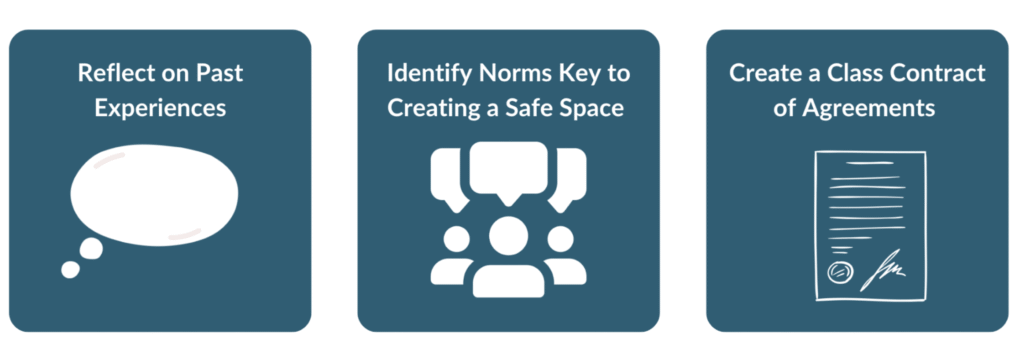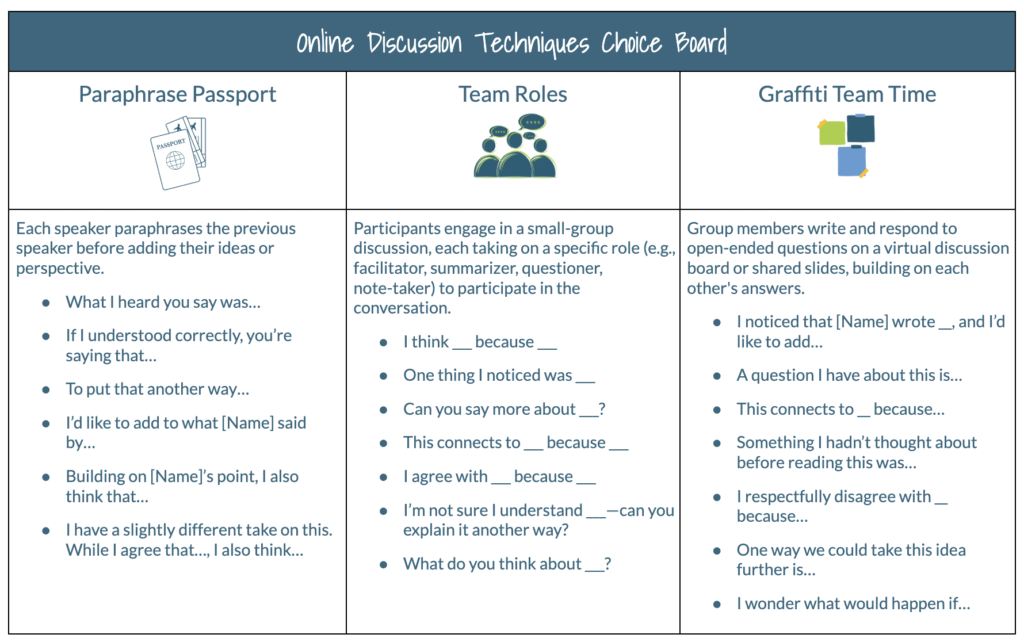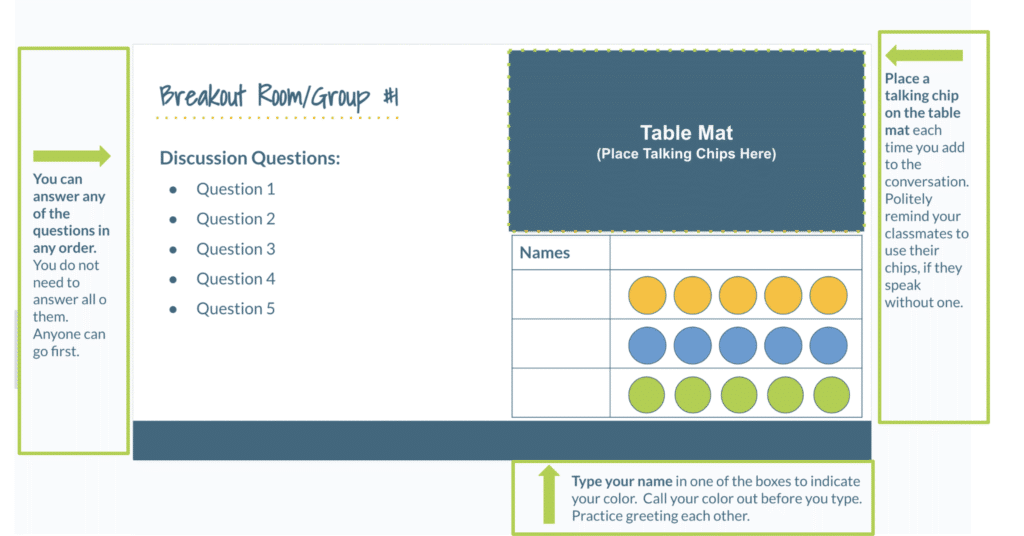Facilitating meaningful discussion in a physical classroom is challenging enough. For educators working partially or entirely online, engaging students in academic discourse can feel exponentially more difficult. During online and remote learning, students may be tempted to turn off cameras, feel disconnected from peers, or experience feelings of isolation as they learn from home.
Despite these potential obstacles, it is critical that students learning online feel connected to a kind, supportive, and engaging learning community. Discussion plays a vital role in building social presence, or the sense of being seen, heard, and valued, in an online course.
Last week, I worked with a group of online educators to explore a range of strategies they can use to facilitate student-led discussions to foster connection, encourage critical thinking, and position students to lead their learning online. In this post, I want to share the strategies and structures I covered in our webinar to help teachers design and guide online discussions that are equitable, meaningful, and student-centered.
Why Prioritize Online Discussions?
When done well, online discussions can accomplish much more than simply checking a participation box. They can:
- Connect students to an online learning community.
- Expose them to diverse perspectives.
- Deepen thinking and improve retention.
- Help students practice academic conversation skills.
- Provide every student with the opportunity to participate.
- Shift students from consumers to producers of knowledge.
They also provide teachers with invaluable formative assessment data, giving us a clearer understanding of what students understand, where they are struggling, and how we might adjust our instruction.
Start with Relationships & Clear Expectations
Before we ask students to speak up, take risks, and engage in real-time online discussions, we must build a solid foundation. That foundation is trust. Students must have trust in the space, in the process, and one another. One of the most effective ways to establish this foundation is by co-creating communication norms with students.
Here’s a simple process I’ve used with teachers and modeled for students that helps set the stage for successful, student-led online conversations.

Step 1: Reflect on Past Experiences
Ask students to reflect on a time when they felt comfortable sharing their thoughts in a class discussion. What made that environment feel safe? Then, flip it—ask them to reflect on a moment when they didn’t feel comfortable speaking up. What made it hard to participate? These reflections help students articulate their understanding of what respectful and inclusive spaces feel like.
Step 2: Small Group Norm-Building
Put students into small breakout groups (3–4 per group) and ask them to share some of the ideas that surfaced in their reflections. Then, have each group identify 3–5 norms they believe are essential to maintaining a safe and respectful online discussion space. They can jot these on a shared slide deck, Jamboard, or virtual post-it wall.
Step 3: Share, Select, and Finalize
Bring the class back together and have each group share their norms along with a quick explanation of why those behaviors matter. Then, give students a chance to review all the norms and vote on the ones they feel are most important—this could be done with emojis, comments, or digital “dots.” The norms that rise to the top become part of your class contract or shared agreement.
Co-creating norms in this way offers multiple benefits: it builds clarity, invites collaboration, and gives students ownership over the expectations that will guide their behavior in online spaces. When students help define the rules, they are far more likely to follow them and support their classmates in doing the same.
Build Relationships with Informal Conversations
Agreements give us a shared foundation, but relationships bring that foundation to life. Before diving into academic discourse, I always recommend starting with a brief check-in or icebreaker. These informal conversations aren’t a waste of time—they’re a warm-up for the mind, the voice, and the community.
Something as simple as “What’s one thing that made you smile this week?” or “What’s your favorite snack during study time?” helps students ease into the discussion space. It lowers the pressure, invites personal connection, and gently nudges students to unmute or type something in the chat before the academic work begins.
These moments help students feel seen and heard, not just as learners, but as people. And when students feel safe and connected, they’re much more likely to take the risks required for deeper academic conversations.
Chunk Live Online Instruction + Pair It with a Cooperative Learning Strategy
We’ve all felt the energy drop in a virtual lesson that’s gone on too long without a pause. To keep students cognitively engaged, try breaking your instruction into short, digestible 3–5 minute chunks, each followed by a discussion prompt using a cooperative strategy like Numbered Heads Together (NHT). Using a strategy like NHT to encourage discussion throughout a direct instruction ensures that students aren’t just absorbing information—they’re interacting with it, processing it collaboratively, and making meaning it in real time.
Here’s how Numbered Heads Together works online:
- Assign students to heterogeneous breakout rooms of about four participants.
- Explain that each student will take a number (1–4) within their group.
- Ask students to rename themselves in Zoom or your video platform to include their number (e.g., “Jordan – #2”). If renaming isn’t possible, have each group designate a notetaker to track who holds each number.
- Present a discussion prompt or question related to a short chunk of instruction. The prompt should invite analysis, explanation, or reflection—not just recall.
- Give students 1–2 minutes to respond individually in the main room before opening the breakout rooms to allow them to discuss the prompt or question as a group.
- In breakout rooms, students “put their heads together” to discuss the prompt or question and determine the strongest or clearest response.
- Bring everyone back to the main room and call on a specific student by number and breakout room (e.g., “Let’s hear from student #3 in Breakout Room 2”). That student unmutes and shares their group’s response on behalf of the team.
- Invite additional students with that same number from other breakout rooms to respond. “What do the other #3s think? Is there anything you want to add or share?”
This strategy works because it actively engages every student in the learning process. Each group member is responsible for understanding the content and contributing to the conversation, knowing that anyone might be called to share on behalf of their group. This element of accountability keeps students focused and encourages full participation.
At the same time, working together to discuss and clarify ideas promotes collaboration and deepens understanding through peer-to-peer teaching. The structure also supports diverse learners by providing time to process information, ask questions, and rehearse responses before speaking in front of the full group. As a result, students build confidence in their thinking and are more likely to share their ideas during whole-class discussions.
And perhaps most importantly, it’s far less intimidating to share an idea when it’s not just your idea—it’s your group’s idea. That shared ownership builds confidence and helps more students feel comfortable speaking up.
Give Students Agency with a Choice of Discussion Techniques
When students are invited to choose how they engage with one another, they’re more likely to participate meaningfully. Providing options supports different communication styles, learning preferences, and comfort levels—especially in online environments where some students may hesitate to unmute or speak up.
A discussion techniques choice board gives students structured, accessible ways to engage in academic conversations. The goal is to ensure all students have an entry point into the discussion.
These structures provide clear norms, model academic discourse, and offer embedded scaffolds (like sentence stems) to support learners at all levels. Most importantly, giving students the agency to choose how they engage builds ownership, motivation, and confidence.
Build Accountability with Virtual Talking Chips
While giving students choice fosters agency, we also need to ensure that every voice is heard. That’s where talking chips come in—a simple but powerful strategy to make participation more equitable. This is a strategy my colleague, Noelle Gutierrez, described in a previous blog to help teachers using the station rotation model engage students in equitable discussions at the offline stations. However, the strategy can be adapted for the online environment as well!
In an online discussion, each breakout room group is assigned a slide and each student in the group receives a set number of “chips” as pictured below. Every time they contribute to the conversation, they place a chip on the mat. The goal is to use all of their chips by the end of the discussion.
This strategy:
- Promotes turn-taking so no one student dominates the discussion.
- Supports quiet or hesitant students by giving them a clear structure and visual reminder to participate.
- Encourages active listening and thoughtful contributions, especially when paired with sentence stems.
- Creates accountability in small groups without putting students on the spot.
When students can visually track their participation—and that of their peers—it shifts the culture from passive listening to shared responsibility. And when everyone knows their voice matters, they’re more likely to speak up, listen closely, and contribute with confidence.
Wrap Up
Strong student participation in online discussions doesn’t happen overnight. It’s something we cultivate over time through intentional design, consistent routines, and structures that lower the barrier to entry and provide the necessary support.
When we clearly communicate expectations, co-create norms, and give students voice and choice in how they engage, we create the conditions for real connection and meaningful discourse. And when we layer in strategies that promote equity—like Numbered Heads Together and talking chips—we help ensure that every student has the opportunity to speak, listen, and learn.
The goal isn’t just to get students talking. It’s to build a culture where they feel safe enough to take risks, supported enough to speak up, and empowered enough to lead the conversation.
The Station Rotation Model and UDL: Elevate Tier I Instruction and Cultivate Learner Agency is available now! I’d love for you to check it out, share it with a colleague, and let me know what resonates most with you. If you have any questions about the book, please post a comment!
School leaders interested in using the book for a staff-wide study can place a discounted bulk order for 10 or more copies. If you and your teachers need additional support, I offer customized professional learning that is hands-on, practice-based, and tailored to your team’s needs. Together, we can support your teachers in developing their UDL practice, differentiating instruction more effectively, and elevating Tier 1 instruction. We can even utilize the Station Rotation Model to create space for Tier 2 support and Tier 3 intervention within general education classrooms. And, we can explore how this model can help us position students as active agents leading their learning!






7 Responses
Thank you, Catlin Tucker, for sharing these valuable insights.
You’re welcome! I am thrilled this was useful.
Best,
Catlin
This is super helpful! I can also see some of this applying to facilitating adult discussions at work. Thank you!
You’re welcome! I am thrilled this was useful. 😊
Best,
Catlin
Love this – the reflections to start are powerful. I would have students list their 3 best experiences in group projects and the 3 worst and each group would create a ‘charter’. (Once in a while, one student’s best experience was someone else’s worst, lol but… )
If it works for ornery senior entrepreneurship students, it should work for any ages. (That’s the great thing about entrepreneurship and innovation, that other than some terminology, you don’t have to dumb it down.)
Anyway, living your blog – very, very few of my peers have had even 1 hour of training in education theory and practice. Keep ’em coming!
oops – trying again 🙂
This is a great model. I’ve had good luck having students share their 3 best & 3 worst experiences in group/team projects then negotiate a “charter”. It’s been good but your ideas will supercharge the process! (These are senior biz students in an entrepreneurship/innovation focused capstone class. who are not used to having this much agency.) So…
THANKS!!!
You are so welcome, Norris! I am glad this was valuable, and I appreciate you sharing what has worked for you!
Best,
Catlin